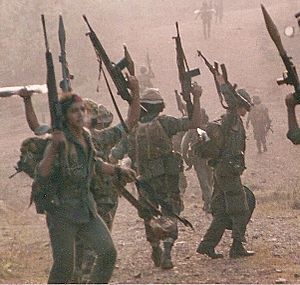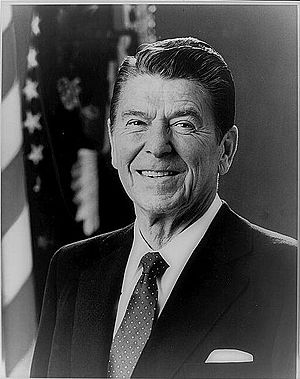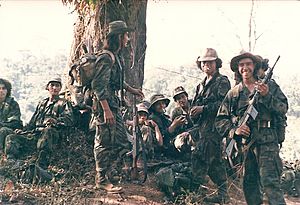Contras facts for kids
The Contras were groups of armed fighters in Nicaragua. Their name comes from the Spanish word contrarrevolucionario, meaning "counter-revolutionary." They were against the Sandinista government, which took power in 1979. This happened after the Somoza family's 43-year rule ended.
The Contras were made up of different groups. They did not all agree on everything. The Sandinistas saw them as violent because many of their attacks harmed regular people. The Contras received help from the United States, especially from the Central Intelligence Agency (CIA). They attacked farms and fuel storage areas in Nicaragua.
Contents
Who Were the Contras?
The first Contra groups started in 1980 and 1981 in Honduras. One main group was the Nicaraguan Democratic Force (FDN). It was led by former army colonel Enrique Bermúdez.
Another group, the Democratic Revolutionary Alliance (ARDE), formed in Costa Rica in 1982. This group included Edén Pastora, a former Sandinista hero. He disagreed with the Sandinista government because he felt Cuba was becoming too influential. Pastora called his group the "southern front" in the fight.
A third group, Misurasata, was made up of Indigenous peoples. These were the Miskito, Sumu, and Rama tribes from Nicaragua's Atlantic coast. They had problems with the Sandinista government.
Why Indigenous Groups Joined
The Misurasata group had several reasons for fighting the Sandinistas:
- The government took control of their traditional lands. This made it hard for them to hunt and fish.
- Many of their leaders were arrested or killed.
- Their villages were bombed or destroyed by the military.
- Young Indigenous people were forced to join the Nicaraguan army.
- About 10,000 Indigenous people were forced to leave their homes. Their villages were then burned.
- The government stopped trade with villages that did not support them.
The United States' Role
The United States played a big part in helping the Contras. When Ronald Reagan became president in 1981, he accused the Sandinistas of being too much like Cuba. He also said they were helping rebels in El Salvador.
In November 1981, President Reagan secretly approved giving the CIA money to support the Contras. This was part of the "Reagan Doctrine." This idea meant the U.S. would help groups fighting against governments supported by the Soviet Union.
World Court and U.S. Aid
In 1984, Nicaragua took the United States to the World Court. In 1986, the court ruled that the U.S. had acted illegally. It said the U.S. should stop using force against Nicaragua. The court also ordered the U.S. to pay for damages. However, the U.S. did not accept the court's decision.
The U.S. Congress later passed the Boland Amendment. This law stopped direct military aid to the Contras. Because of this, some U.S. officials secretly tried to find other ways to fund the Contras. This led to the Iran-Contra Affair in 1986-1987.
In 1988, the United States House of Representatives rejected President Reagan's request for more money for the Contras.
End of the Conflict
U.S. officials also helped bring the different Contra groups together. In 1985, they formed the United Nicaraguan Opposition. Later, in 1987, they created the Nicaraguan Resistance.
Some Contra leaders left the movement. The Misurasata group also made a deal with the Sandinista government in 1985. This helped reduce fighting among the Indigenous people.
Other Central American governments helped find a peaceful solution. This led to the Sapoa ceasefire agreement on March 23, 1988. This agreement helped the Contras disarm and rejoin Nicaraguan society. It also led to new elections, which were held on February 25, 1990. An anti-Sandinista group won these elections.
Some Contras briefly returned to fighting in the 1990s. They were sometimes called recontras. But these groups were later convinced to disarm again.
Related pages
Images for kids
-
Contra rebels marching through Jinotega in 1985
See also
 In Spanish: Contras para niños
In Spanish: Contras para niños





